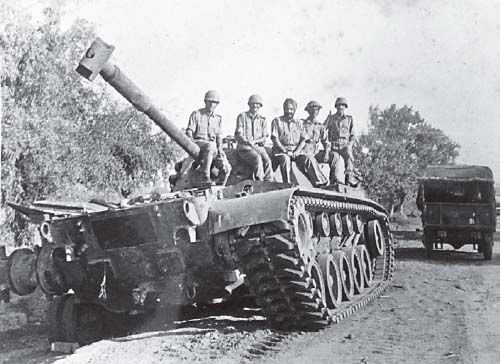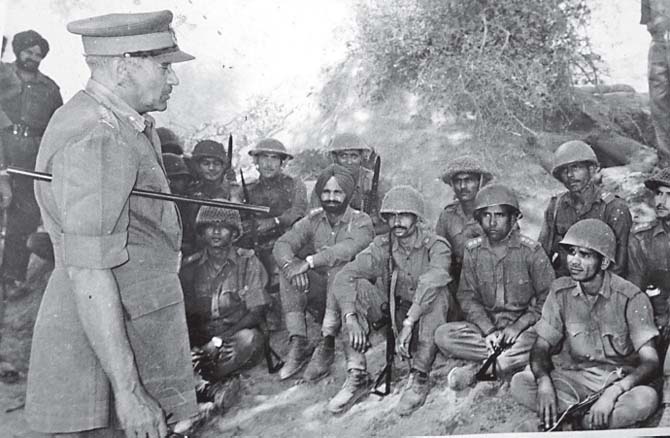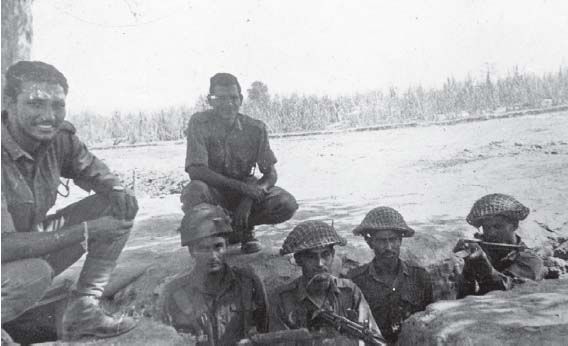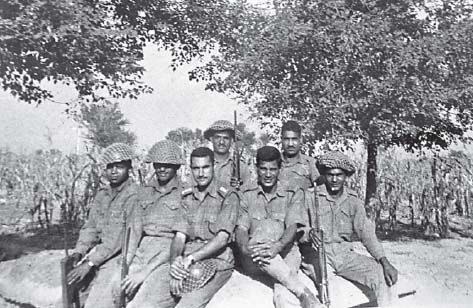'News is rife that Pakistan will attack the next day. They have no idea that this is where they will take on the might of 1 Armoured Division of Pakistan in a three-day bloody battle that will be remembered in military history as the Battle of Asal Uttar.'
Rachna Bisht Rawat salutes the brave men who turned the tide of the 1965 War.

On the morning of 1 September 1965, the nation woke up to a startling announcement on All India Radio.
'Pakistan has launched a massive attack with tanks and heavy artillery in the Chamb sector of Jammu and Kashmir. The enemy's objective seems to be the strategic Akhnoor Bridge. Prime Minister Lal Bahadur Shastri has declared that Pakistan will be given a fitting reply by the Indian Army,' it said.
The prime minister's statement was later described by Lieutenant General Harbaksh Singh (retd), VrC, then the General Officer Commanding-in-Chief (GOC-in-C), Western Command, as 'the tallest of decisions taken by one of the shortest of men.'
***
6 September 1965
It is a warm September afternoon when the Grenadiers reach Dibbipura, one of the last towns on the Indo-Pak border.
Lush sugar cane fields interspersed with ripening cotton stretch for miles around them. Where the International Border separates India from Pakistan, however, the land is barren. All that they can see is sarkanda or elephant grass growing wild all the way to Ichhogil Canal that roughly marks Pakistan's boundary.
Twenty-two-year-old Lieutenant Hari Ram Janu is wading through chest-deep water, his .303 rifle held above his head as he trudges through the sarkanda that lashes his slush caked body.
Around him are 600 soldiers of his battalion, each at a distance of about 5.5 metres from the other, each holding his weapon high, ensuring that the water does not touch the ammunition packs strapped to their bodies.
Artillery shells whistle past, quickening their heartbeat and triggering a buzz in their ears; above their heads, enemy bullets fly relentlessly. Pakistani soldiers have spotted them from the other side of Ichhogil and opened the gates of the canal, flooding the area completely.
Undeterred by the water soaking them to the bone, and ignoring the bullets, the men trudge on. The unit has been tasked to cross the International Border and capture the strategically located Theh Pannu Bridge on Ichhogil Canal.
Amongst the soldiers is CQMH (Company Quarter Master Havildar) Abdul Hamid who will bring laurels to the unit a few days later, but as of now he is just one of the many brave soldiers who are stoically putting their lives at risk to teach Pakistan a lesson it will not forget.
***

The Battle of Asal Uttar
The soldiers walk 4 km in their wet uniforms to reach Dibbipura where they halt for food. They then walk another 7 km to reach Chima village, the area they are to defend.
Darkness is falling when the tired and sleep-deprived men start digging trenches and covering them with sugarcane stalks plucked from the fields so that they are not visible to enemy planes.
It has been three days since they have changed their clothes, and the stink and grime of the water through which they have trudged cling to their sunburned and wind-lashed skin.
They spend another anxious night in their shallow trenches, flitting in and out of sleep. News is rife that Pakistan will attack the next day. They have no idea that this is where they will take on the might of 1 Armoured Division of Pakistan in a three-day bloody battle that will be remembered in military history as the Battle of Asal Uttar.
That it is fought in the village of Asal Uttar (which means 'befitting reply' in Hindi) is a coincidence that would not be lost on the soldiers.
***

That day the Grenadiers face three tank attacks. The tanks come down the road in sets of three -- at 9.30 am, 11.30 am and finally at 2.30 pm.
Hamid destroys two tanks and Hav Bir Singh of B coy another two.
Some of the anti-tank mines that had been laid the previous night are heard exploding and a few more tanks are disabled and deserted by the Pakistanis.
The soldiers settle down for another night of fitful sleep. They know now that an entire Patton tank division of the Pakistan army has been attacking them.
However, they have faith in their World War II vintage recoilless rifles that have smashed, disabled and led to the abandonment of more tanks than an armoured formation could hope for in a tank-to-tank battle.
***
 On 10 September, the day dawns bright but the Company Commanders are wary. They are expecting an Infantry attack. Every man is alert in his trench, finger on trigger.
On 10 September, the day dawns bright but the Company Commanders are wary. They are expecting an Infantry attack. Every man is alert in his trench, finger on trigger.
Nothing happens till 8.30 am, when they hear the rumble of enemy tanks again. Three Pattons are coming down the road -- the first trundling down the middle, the other two following, one on either side.
IMAGE: Havildar Abdul Hamid, Param Vir Chakra.
Hamid spots the first tank when it is 180-odd metres away, allows it to get closer and smashes it, quickly moving his jeep away so that its location is not picked up by the enemy.
As had happened earlier, the soldiers in the remaining tanks flee. At 9 am enemy shelling intensifies and many start landing in the C coy area, though nobody is injured. Soon the men spot another armoured attack.
Hamid destroys his sixth tank. He spots the seventh tank at the same time that it spots him. There is no time to change position in the face of relentless artillery fire. Telling his driver and loader to get under cover, he aims his gun at the Patton even as it places him in its sight.
Two simultaneous explosions rend the air -- the tank as well as Hamid's jeep blow each other up simultaneously. The brave soldier is dead, but there is no time to mourn as three enemy RCL jeeps from the Reconnaissance and Support Battalions come down the road.
***
All India Radio broadcast the news of the capture of Pattons in its afternoon bulletin. So many enemy tanks littered the area that Lieutenant Colonel Caleb requested the Brigade Commander to arrange for numbering the enemy tanks with paint in order to make counting easier.
All the turrets of the captured enemy tanks therefore showed a number in white paint in addition to their original Urdu serial numbers.
Later that evening, 3 Cavalry recovered another war trophy -- Operational order no G-3548 (copy no 3) of Pakistan's 4 Armoured Brigade, dated 8 September 1965.
This clearly stated that 4 Armoured Brigade was to secure the Beas Bridge on the main Grand Trunk Road. The order now hangs in the Regimental Officers' mess.
Lieutenant Colonel Caleb called it a 'colossal enemy dream come untrue.'

At 3.30 am on 13 September 1965, the shelling finally stopped. A queer silence descended on the battlefield of Asal Uttar. Ceasefire had been imposed.
It is remarkable that 9 Horse, 4 Grenadiers, 3 Cavalry and 21 Rajasthan Rifles successfully held back an entire armoured division (350 tanks) of Pakistan for seventy-two hours.
For the valour the battalion displayed on the battlefield, 4 Grenadiers was awarded nine Sena Medals, two Vishisht Seva Medals (VSM) and the Battle Honour Asal Uttar.
CQMH Abdul Hamid was posthumously decorated with the Param Vir Chakra, the highest gallantry award of India.
Military historian Steven Zaloga says that Pakistan admitted to losing 165 tanks during the 1965 war, more than half of which were knocked out during the Battle of Asal Uttar.
A famous participant in the battle was Pervez Musharraf, who went on to become army chief of staff and president of Pakistan. At the time, Musharraf was a young lieutenant of artillery in the 16 (SP) Field Regiment, 1st Armoured Division Artillery.
Its back broken, the Pakistani Armoured Division eventually decided to pull out and go towards Sialkot, leaving troops behind in Khem Karan.
Excerpted from 1965: Stories from the Second Indo-Pak War by Rachna Bisht Rawat. Penguin Viking, with the publisher's kind permission.
OUR SPECIAL SERIES: THE 1965 WAR, 50 YEARS LATER
- Param Vir Chakra Abdul Hamid, a Hero's Hero
- My Father, the Param Vir Chakra Winner
- The daredevil fighter pilot who survived a Pakistani bullet
- My salute to arguably India's greatest military hero
- Two wars and a romance
- The war that helped India regain its military confidence
- The central lesson from the '65 war
- The general who saved Punjab in the '65 war
- You can buy Rachna Bisht Rawat's The Brave, Param Vir Chakra Stories here.










